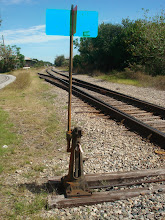It's been a while since I've posted an update ...life happens fast! I have been thinking about module legs and what to do with the first module frames I built with the intent that they would be a yard or perhaps staging. I originally built folding legs since these modules are 6' in length and could accept the long legs utilized for Free-moN rail head height standard of 50". Since the legs overlapped when folded they needed to be offset from each other resulting in leg sets somewhat narrower than the already narrow 12" module width. The height, narrow leg sets, and hinged mounting all contributed to make the modules less stable than I desired. I realize stability increases once modules are set up but I still had concerns in case I wanted to use these modules as end point staging in a setup. They would then only be connected on one end cutting back on the desired stability.
So I was trying to decide if I really wanted to use the modules. Before scrapping them I decided to try a different leg attachment. I proceeded to rebuild one of the module's legs sets as fixed (bolt or clamp on). The leg sets were broader and were attached much more firmly than with the plain hinges and folding braces as before. As you would guess this did increase stability somewhat. About that time I ran across a post on the Free-moN Yahoo Group that mentioned the use of conduit for legs. So I proceeded to fabricate a set of conduit legs for the second module.
I purchased some 1/2" metal electrical conduit. Adjustable feet, allowance for module deck thickness, roadbed, etc. will determine exact length but each leg needed to be somewhere north of 48". Two 10' lengths were sufficient to make four legs and were only around a couple of dollars a piece. A small pipe cutter made fairly quick work of cleanly cutting the legs to length. I cut 45 degree corner braces out of some plywood scrap and attached a 10-24 x 5/16 T-nut centered on the back side of each. I then mounted them into each corner of the module using four screws.
I used a 3/16" x 2" eye bolt as a set screw in the T-nut to effectively secure each conduit leg into the corner of the module.
This view shows the legs attached at one end of the module. The corner braces and end plate will be painted to match the module frame and seal the wood against moisture.
Here is a view of the module standing on its new legs. Being in the corners of the frame the legs are effectively braced on two sides and seem to provide a significantly sturdier stance than the wooden leg sets I fabricated for the other module. I plan to play with adjusting module height by adjusting the set of the legs in their respective "pockets". If that is too finicky I plan to press fit a hex nut (as mentioned in the Yahoo Groups posting) into the bottom of each leg to accept an eye bolt for height adjustment.
Some advantages of the conduit legs are they are simple to fabricate, interchangeable, easy to transport, relatively inexpensive, and they don't require painting. Now I just need to decide if I want to retrofit the other staging/yard module and ultimately the Tarragona Street and other modules for the Pensacola scene.







